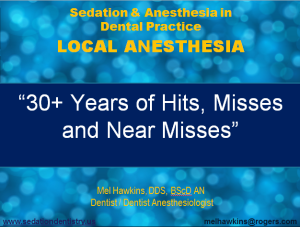Local Anesthesia:
32+ Years of Hits, Misses and Near Misses
Lecture recommended for Dentists, Auxiliaries, Licensed Hygienists, Students
Program Synopsis
 This presentation discusses the reasons for the lack of effective anesthesia with emphasis on mandibular technique. The neuro-anatomy and histology of the pterygo-mandibular triange is reviewed to enhance understanding of the complexities of the inferior alveolar block. This is essential toward developing a logical approach to needle placement within these structures. This concept can ensure the successful application of what is within our control and will help to minimize those factors which may be outside of our control.
This presentation discusses the reasons for the lack of effective anesthesia with emphasis on mandibular technique. The neuro-anatomy and histology of the pterygo-mandibular triange is reviewed to enhance understanding of the complexities of the inferior alveolar block. This is essential toward developing a logical approach to needle placement within these structures. This concept can ensure the successful application of what is within our control and will help to minimize those factors which may be outside of our control.
Clinical pharmacology, including articaine, and vasoconstrictor drug interactions will be evaluated. After a thorough review of the “pros and cons” of the conventional inferior alveolar block, the Akinosi and Gow-Gates mandibular blocks are reviewed and then amalgamated in a “mixed” or hybrid approach.
Multi-tasking supplementation with infiltrative and advanced techniques, combined with other “tips and tricks” can result in a predictably higher rate of success.
Learning Objectives
- To understand the reasons for failure of block anesthesia: “What we can control and what can we not control?”
- To review the pharmacology of local anesthetics: the risks/benefits of articaine and vasoconstrictor drug interactions
- The Conventional Inferior (?) Alveolar Block: 100 years in the making. The 12 “Tips and Tricks” toward enhancing success
- To understand that the higher “hybrid” blocks are easy to learn and adapt to your practice
- To examine technique application supplementation including the current status of infiltration anesthesia in the mandible
- Case Reports: “What would you do, Doctor?”
